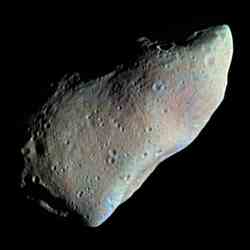
Asteroid. Image credit: U.S. Geological Survey Click to enlarge
A University of Michigan-led research team has discovered that for the first time in history, scientists will be able to observe how the Earth’s gravity will disrupt a massive asteroid’s spin.
Scientists predict a near-miss when Asteroid 99942 Apophis, also known as the 2029 meteor, passes Earth in 2029. An asteroid flies this close to the planet only once every 1,300 years. The chance to study it will help scientists deal with the object should it threaten collision with Earth.
Only about three Earth diameters will separate Apophis and Earth when the 400-meter asteroid hurtles by Earth’s gravity, which will twist the object into a complex wobbling rotation. Such an occurrence has never been witnessed but could yield important clues to the interior of the sphere, according to a paper entitled, “Abrupt alteration of the spin state of asteroid 99942 Apophis (2004 MN4) during its 2029 Earth flyby,” accepted for publication in the journal Icarus.
The team of scientists is led by U-M’s Daniel Scheeres, associate professor of aerospace engineering, and includes U-M’s Peter Washabaugh, associate professor of aerospace engineering.
Apophis is one of more than 600 known potentially hazardous asteroids and one of several that scientists hope to study more closely. In Apophis’ case, additional measurements are necessary because the 2029 flyby could be followed by frequent close approaches thereafter, or even a collision.
Scheeres said not only is it the closest asteroid flyby ever predicted in advance, but it could provide a birds-eye view of the asteroid’s “belly.”
“In some sense it’s like a space science mission ‘for free’ in that something scientifically interesting will happen, it will be observable from Earth, and it can be predicted far in advance,” Scheeres said.
If NASA places measuring equipment on the asteroid’s surface, scientists could for the first time study an asteroid’s interior, similar to how geologists study earthquakes to gain understanding of the Earth’s core, Scheeres said. Because the torque caused by the Earth’s gravitational pull will cause surface and interior disruption to Apophis, scientists have a unique opportunity to observe its otherwise inaccessible mechanical properties, Scheeres said. Throwing the asteroid off balance could also affect its orbit and how close it comes to Earth in future years.
“Monitoring of this event telescopically and with devices placed on the asteroid’s surface could reveal the nature of its interior, and provide us insight into how to deal with it should it ever threaten collision,” Scheeres said.
The asteroid will be visible in the night sky of Europe, Africa and Western Asia.
The asteroid was discovered late last year and initially scientists gave it a 1-in-300 chance of hitting the Earth on April 13, 2029. Subsequent analysis of new and archived pre-discovery images showed that Apophis won’t collide with Earth that day, but that later in 2035, 2036, and 2037 there remains a 1-in-6,250 chance that the asteroid could hit Earth, Scheeres said. Conversely, that’s a 99.98 percent chance that the asteroid will miss Earth.
The asteroid is relatively small, about the length of three football fields. If it hit it wouldn’t create wide-scale damage to the Earth, but would cause major damage at the impact site, Scheeres said.
The team of scientists also includes Lance Benner and Steve Ostro of NASA’s Jet Propulsion Laboratory, Alessandro Rossi of ISTI-CNR, Italy, and Francesco Marzari of the University of Padova, Italy.

Hey, nice tips. Perhaps I’ll buy a bottle of beer to that person from that forum who told me to go to your site 🙂